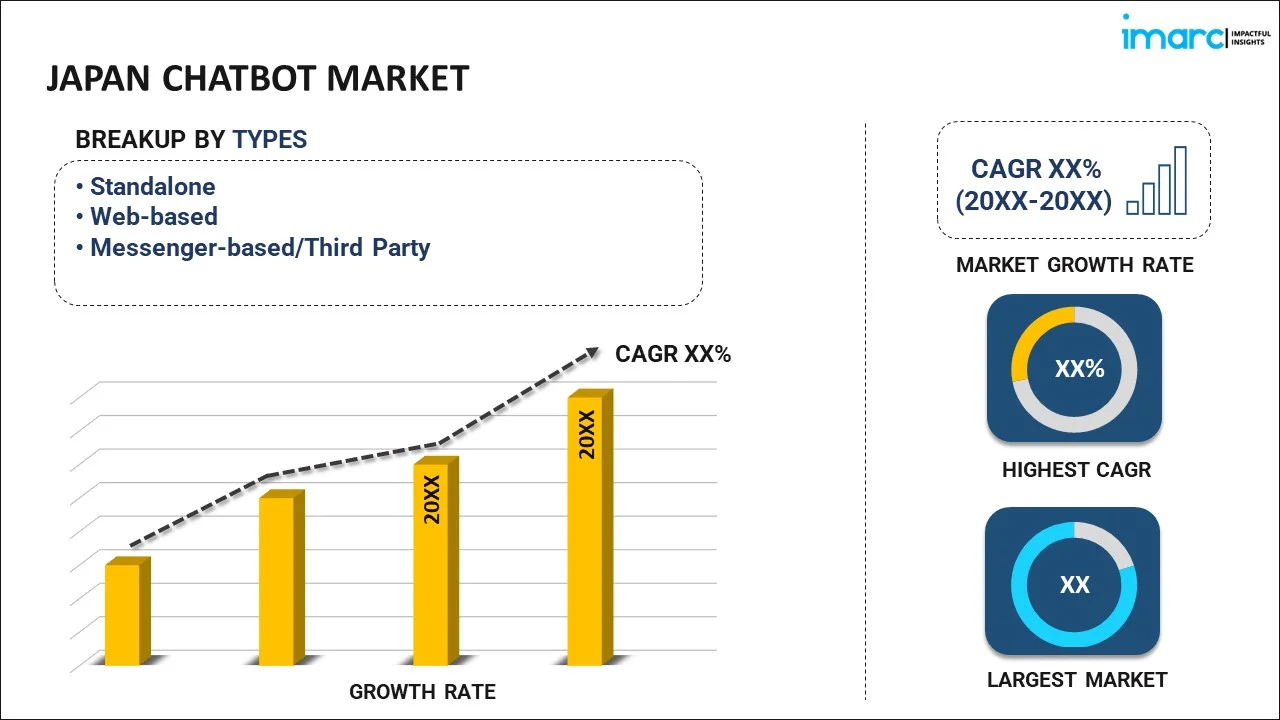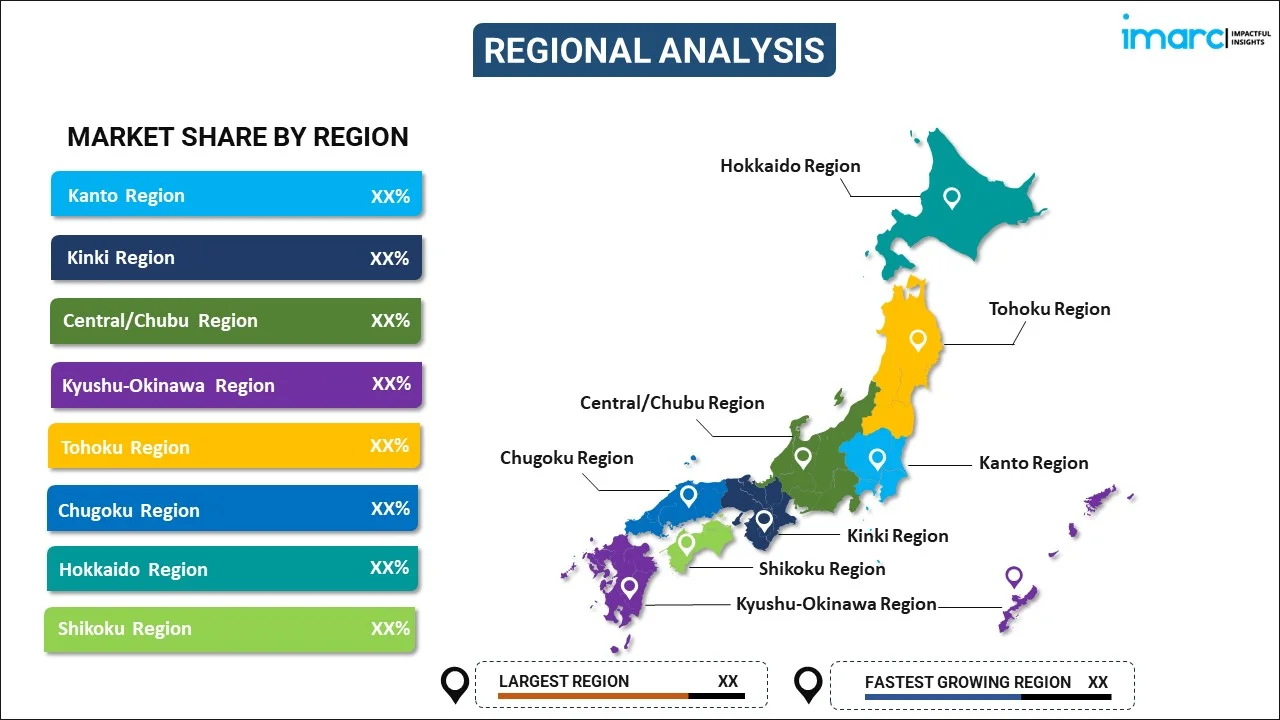
Japan Chatbot Market Report by Type (Standalone, Web-based, Messenger-based/Third Party), Product (Artificial Intelligence, Marketing, Human Intelligence), Application (Bots for Service, Bots for Social Media, Bots for Payments/Order Processing, Bots for Marketing, and Others), Organization Size (Small Enterprises, Medium Enterprises, Large Enterprises), Vertical (Healthcare, Retail, Banking, Financial Services, and Insurance, Media and Entertainment, Travel and Tourism, E-Commerce, and Others), and Region 2025-2033
Market Overview:
The Japan chatbot market size reached USD 414.0 Million in 2024. Looking forward, IMARC Group expects the market to reach USD 2,040.6 Million by 2033, exhibiting a growth rate (CAGR) of 19.4% during 2025-2033. The escalating promotion and funding of AI research and development, the widespread integration of chatbots in customer service, and the COVID-19 pandemic prompting businesses to shift towards digital platforms represent some of the key factors driving the market.
|
Report Attribute
|
Key Statistics
|
|---|---|
|
Base Year
|
2024 |
|
Forecast Years
|
2025-2033
|
|
Historical Years
|
2019-2024
|
| Market Size in 2024 | USD 414.0 Million |
| Market Forecast in 2033 | USD 2,040.6 Million |
| Market Growth Rate (2025-2033) | 19.4% |
A chatbot is a software application designed to simulate human conversation. It interacts with users through text or voice communication, mimicking human responses to questions and commands. Chatbots utilize natural language processing (NLP) algorithms, allowing them to understand and process human language, thereby engaging in meaningful dialogues. They can be integrated into various platforms such as websites, mobile apps, and messaging applications. Numerous businesses utilize chatbots to provide immediate, 24/7 customer service, addressing common inquiries without human intervention. This enhances efficiency and offers a consistent user experience. They are also used in other fields such as healthcare for patient assistance or in finance for personal financial management. The growing sophistication of AI technology enables chatbots to provide increasingly complex and personalized interactions. They can be rule-based, where responses are pre-determined, or more advanced, leveraging machine learning to understand context and intent for more nuanced communication. The use of chatbots has seen significant growth in recent years, driven by technological advancements and the growing need for on-demand, virtual services. They are becoming a vital tool in enhancing customer engagement and are seen as a crucial part of the future digital landscape.
Japan Chatbot Market Trends:
The market for chatbots in Japan is experiencing substantial growth, driven by the country's focus on technological innovation and artificial intelligence. Additionally, the Japanese government is actively promoting and funding AI research and development. Therefore, this is significantly supporting the market. Along with this, the integration of chatbots in customer service has been a response to the increasing demand for 24/7 support, especially in industries such as banking, retail, and healthcare. Japan's aging population is also contributing to the rise of chatbots, as businesses seek to streamline operations and manage labor shortages through automation. In addition, cultural factors also play a part, as the Japanese market often prefers indirect and non-intrusive customer service, a niche where chatbots excel. Apart from this, the COVID-19 pandemic has prompted businesses to shift towards digital platforms, further driving the need for virtual communication tools. The rise of smartphone usage in Japan has made access to chatbot services easier and more widespread, contributing to their popularity. In confluence with this, significant investments in machine learning and natural language processing technologies have enhanced the efficiency and human-like interaction of chatbots. Furthermore, collaborations between tech companies and traditional industries are fostering innovative applications for chatbots, such as personal finance management or mental health support. The advancement in secure and robust cloud infrastructure in Japan has also enabled the seamless integration of chatbots across various platforms. Some of the other factors driving the market include the growing penetration of the Internet of Things (IoT), rapid digitization, and inflating disposable income levels of individuals.
Japan Chatbot Market Segmentation:
IMARC Group provides an analysis of the key trends in each segment of the Japan chatbot market report, along with forecasts at the country level for 2025-2033. Our report has categorized the market based on type, product, application, organization size, and vertical.
Type Insights:

- Standalone
- Web-based
- Messenger-based/Third Party
The report has provided a detailed breakup and analysis of the market based on the type. This includes standalone, web-based, and messenger-based/third party.
Product Insights:
- Artificial Intelligence
- Marketing
- Human Intelligence
A detailed breakup and analysis of the market based on the product have also been provided in the report. This includes artificial intelligence, marketing, and human intelligence.
Application Insights:
- Bots for Service
- Bots for Social Media
- Bots for Payments/Order Processing
- Bots for Marketing
- Others
The report has provided a detailed breakup and analysis of the market based on the application. This includes bots for service, bots for social media, bots for payments/order processing, bots for marketing, and others.
Organization Size Insights:
- Small Enterprises
- Medium Enterprises
- Large Enterprises
A detailed breakup and analysis of the market based on the organization size have also been provided in the report. This includes small enterprises, medium enterprises, and large enterprises.
Vertical Insights:
- Healthcare
- Retail
- Banking, Financial Services, and Insurance
- Media and Entertainment
- Travel and Tourism
- E-Commerce
- Others
The report has provided a detailed breakup and analysis of the market based on the vertical. This includes healthcare, retail, banking, financial services, and insurance, media and entertainment, travel and tourism, e-commerce, and others.
Regional Insights:

- Kanto Region
- Kinki Region
- Central/ Chubu Region
- Kyushu-Okinawa Region
- Tohoku Region
- Chugoku Region
- Hokkaido Region
- Shikoku Region
The report has also provided a comprehensive analysis of all the major regional markets, which include Kanto Region, Kinki Region, Central/ Chubu Region, Kyushu-Okinawa Region, Tohoku Region, Chugoku Region, Hokkaido Region, and Shikoku Region.
Competitive Landscape:
The report has also provided a comprehensive analysis of the competitive landscape in the market. Competitive analysis such as market structure, key player positioning, top winning strategies, competitive dashboard, and company evaluation quadrant has been covered in the report. Also, detailed profiles of all major companies have been provided.
Japan Chatbot Market Report Coverage:
| Report Features | Details |
|---|---|
| Base Year of the Analysis | 2024 |
| Historical Period | 2019-2024 |
| Forecast Period | 2025-2033 |
| Units | Million USD |
| Scope of the Report | Exploration of Historical and Forecast Trends, Industry Catalysts and Challenges, Segment-Wise Historical and Predictive Market Assessment:
|
| Types Covered | Standalone, Web-based, Messenger-based/Third Party |
| Products Covered | Artificial Intelligence, Marketing, Human Intelligence |
| Applications Covered | Bots for Service, Bots for Social Media, Bots for Payments/Order Processing, Bots for Marketing, Others |
| Organization Sizes Covered | Small Enterprises, Medium Enterprises, Large Enterprises |
| Verticals Covered | Healthcare, Retail, Banking, Financial Services, and Insurance, Media and Entertainment, Travel and Tourism, E-Commerce, Others |
| Regions Covered | Kanto Region, Kinki Region, Central/ Chubu Region, Kyushu-Okinawa Region, Tohoku Region, Chugoku Region, Hokkaido Region, Shikoku Region |
| Customization Scope | 10% Free Customization |
| Post-Sale Analyst Support | 10-12 Weeks |
| Delivery Format | PDF and Excel through Email (We can also provide the editable version of the report in PPT/Word format on special request) |
Key Questions Answered in This Report:
- How has the Japan chatbot market performed so far and how will it perform in the coming years?
- What has been the impact of COVID-19 on the Japan chatbot market?
- What is the breakup of the Japan chatbot market on the basis of type?
- What is the breakup of the Japan chatbot market on the basis of product?
- What is the breakup of the Japan chatbot market on the basis of application?
- What is the breakup of the Japan chatbot market on the basis of organization size?
- What is the breakup of the Japan chatbot market on the basis of vertical?
- What are the various stages in the value chain of the Japan chatbot market?
- What are the key driving factors and challenges in the Japan chatbot?
- What is the structure of the Japan chatbot market and who are the key players?
- What is the degree of competition in the Japan chatbot market?
Key Benefits for Stakeholders:
- IMARC’s report offers a comprehensive quantitative analysis of various market segments, historical and current market trends, market forecasts, and dynamics of the Japan chatbot market from 2019-2033.
- The research study provides the latest information on the market drivers, challenges, and opportunities in the Japan chatbot market.
- Porter's five forces analysis assist stakeholders in assessing the impact of new entrants, competitive rivalry, supplier power, buyer power, and the threat of substitution. It helps stakeholders to analyze the level of competition within the Japan chatbot industry and its attractiveness.
- Competitive landscape allows stakeholders to understand their competitive environment and provides an insight into the current positions of key players in the market.
Need more help?
- Speak to our experienced analysts for insights on the current market scenarios.
- Include additional segments and countries to customize the report as per your requirement.
- Gain an unparalleled competitive advantage in your domain by understanding how to utilize the report and positively impacting your operations and revenue.
- For further assistance, please connect with our analysts.
 Inquire Before Buying
Inquire Before Buying
 Speak to an Analyst
Speak to an Analyst
 Request Brochure
Request Brochure
 Request Customization
Request Customization




.webp)




.webp)












